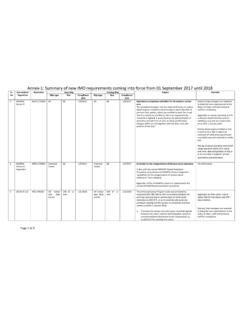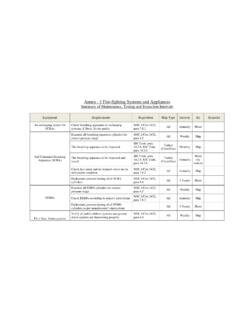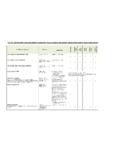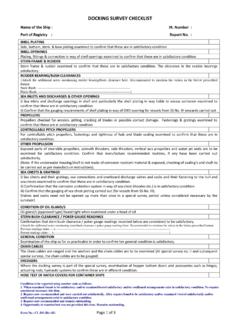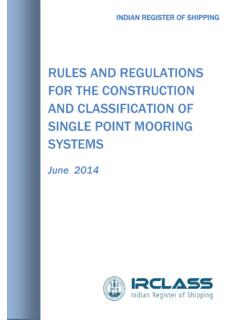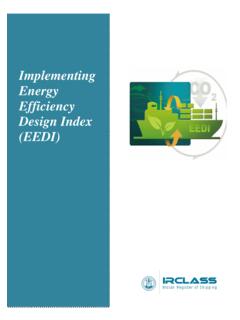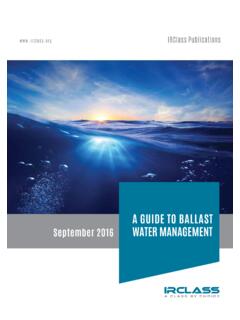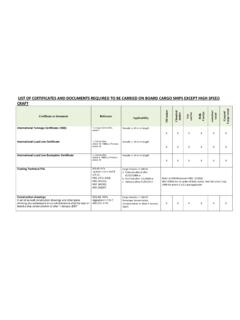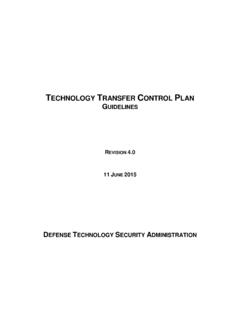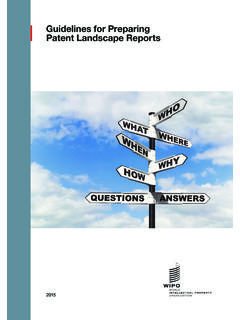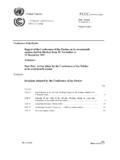Transcription of Ballast Water Management 2016 - IRCLASS
1 guidelines on Ballast Water Management 2016 . guidelines on Ballast Water Management 2016 Indian Register of Shipping IRS-G-ENV-01 Page | 2 guidelines on Ballast Water Management 2016 Introduction Ballast Water is important for safe and efficient operation of vessels; however it also leads to a variety of marine organisms being transported from one environment to another. Studies have revealed that invasion of such organisms causes harmful ecological, economic and health effects in the host environment. To regulate the Ballast Water discharge from ships and to control the transfer of invasive species; The International Maritime Organization adopted the INTERNATIONAL CONVENTION FOR THE CONTROL AND Management OF.
2 SHIP'S Ballast Water AND SEDIMENTS (BWM Convention) in February 2004. The purpose of the Convention is to prevent, minimize and ultimately eliminate the risk of introduction of Harmful Aquatic Organisms and Pathogens which use the Ballast Water as a hub. These guidelines on Ballast Water Management have been developed by the Indian Register of Shipping, in order to assist the ship owners, ship designers and shipyards in implementing the Convention and in decision making. The guidelines are divided into two parts. Part A Ballast Water Management Convention and Ballast Water Treatment Solutions Part B Type Approval of BWMS. Indian Register of Shipping IRS-G-ENV-01 Page | 3 guidelines on Ballast Water Management 2016 Indian Register of Shipping IRS-G-ENV-01 Page | 4 guidelines on Ballast Water Management 2016 Part A.
3 Ballast Water Management Convention and Ballast Water Treatment Solutions Indian Register of Shipping IRS-G-ENV-01 Page | 5 guidelines on Ballast Water Management 2016 Indian Register of Shipping IRS-G-ENV-01 Page | 6 guidelines on Ballast Water Management 2016 Scope The International Maritime Organization (IMO) has developed international legislation, the International Convention for the Control and Management of Ships' Ballast Water and Sediments , to regulate discharges of Ballast Water and reduce the risk of introducing non-native species from ships' Ballast Water . In accordance with the Convention, the Ballast Water Management System (BWMS).
4 Installed on board a vessel is to be an IMO Member State type-approved and certified system and the installation of this system must have the prior approval/ acceptance of the vessel's flag Administration. Each BWMS is tested, approved and certified in its standard product configuration. However there are design and engineering issues, as well as special considerations relating to Class requirements that will need to be addressed, as every ship is unique due to its design and operational profile. The requirement for Ballast Water treatment has arisen from the requirements of regulation D-2 of the Convention. In response to this, a number of technologies have been developed to meet the requirements of the Ballast Water Management Convention and shipboard operation.
5 The techno-economic considerations to be evaluated before selection of a suitable treatment system are many. Owners therefore face a complex task in choosing and installing the appropriate treatment systems particularly when past experience on operation and installation of such systems does not exist. These guidelines have been prepared to summarize the current state of Ballast Water treatment regulations and available technologies in order to provide useful guidance to ship owners, operators, and builders in their decisions about suitable treatment options for new construction as well as existing ships . Indian Register of Shipping IRS-G-ENV-01 Page | 7 guidelines on Ballast Water Management 2016 Table of Contents 1 The Issue 2 The Response 3 Ballast Water Management Regulations IMO Ballast Water Convention 2004.
6 The United States Coast Guard (USCG) Regulations 4 Ship Requirements (IMO BWM Convention, 2004). Ballast Water Management Options Sediment Management Ballast Water Management Plan (BWMP). Ballast Water Record Book (BWRB). 5 Compliance with IMO BWM Convention, 2004. Planning for Compliance BWMS Selection Criteria Procurement Specifications Information from Supplier Technical Considerations Evaluation Checklists Factors impacting BWT Plant Selections Treatment Technology Factors General Treatment Systems factors Installations Challenges 6 Surveys and Certification General Approval of Plans Installation Automation Electrical Equipment Guidance Indian Register of Shipping IRS-G-ENV-01 Page | 8 guidelines on Ballast Water Management 2016 1.
7 The Issue Water has been conventionally used as Ballast to stabilize ships at sea. Ballast Water is pumped- in to maintain safe and efficient operating conditions throughout a voyage, but it also poses a serious ecological, economic and health threat through the transfer of invasive aquatic species inadvertently carried in it. Ballast Water contains a variety of organisms including bacteria and viruses and the adult and larval stages of the many marine and coastal plants and animals. While the vast majority of such organisms will not survive to the point when the Ballast is discharged, some may survive and thrive in their new environment.
8 These non-native species', if they become established, can have a serious ecological, economic and public health impact on the receiving environment. 2. The Response The inadvertent transfer of harmful aquatic organisms and pathogens in the Ballast Water of ships has been determined to have caused a significant adverse impact to many of the world's coastal regions. In 1988, Canada and Australia first reported on invasive marine species in Ballast waters. In response, in 1993, IMO adopted Res. A. 774(18) guidelines for preventing the introduction of unwanted aquatic organism and pathogens from ship's Ballast Water and sediments discharges.
9 Later, The international maritime community, under the guidance of IMO developed International Conventions for the Control and Management of Ship's Ballast Water and Sediments, 2004 , ( Ballast Water Management Convention), which was adopted at the diplomatic conference held at IMO Headquaters in London on 13 February 2004. This convention is aimed at preventing the introduction of unwanted aquatic organisms and pathogens through the discharge of Ballast Water and sediments. The convention will enter into force on 08 Sep 2017. In addition to the IMO, other national bodies have introduced regulations in response to national concerns. The most influential of these is the United States Coast Guard (USCG) which has established both regulations and guidelines to prevent the introduction and spread of aquatic nuisance species.
10 The US Coast Guard (USCG) published its final rule on Ballast Water Management for Control of Non-indigenous Species in Waters of the United States on 23 March 2012. The USCG. Regulations 33 CFR Part 151 and 46 CFR Part 162 entered into force on 21 June 2012 and apply to new ships constructed on or after 1 December 2013 as well as to existing ships by their first dry- docking after 2014 or 2016 depending on their BW capacity. Indian Register of Shipping IRS-G-ENV-01 Page | 9 guidelines on Ballast Water Management 2016 3. Ballast Water Management Regulations IMO Ballast Water Convention, 2004. Overview The International Conventions for the Control and Management of Ship's Ballast Water and Sediments, 2004 (hereinafter referred as the "BWM Convention 2004") consists of: Preamble, 22 Articles and an Annex (refer Table ) which has : o 24 Regulations and o 2 Appendices.
